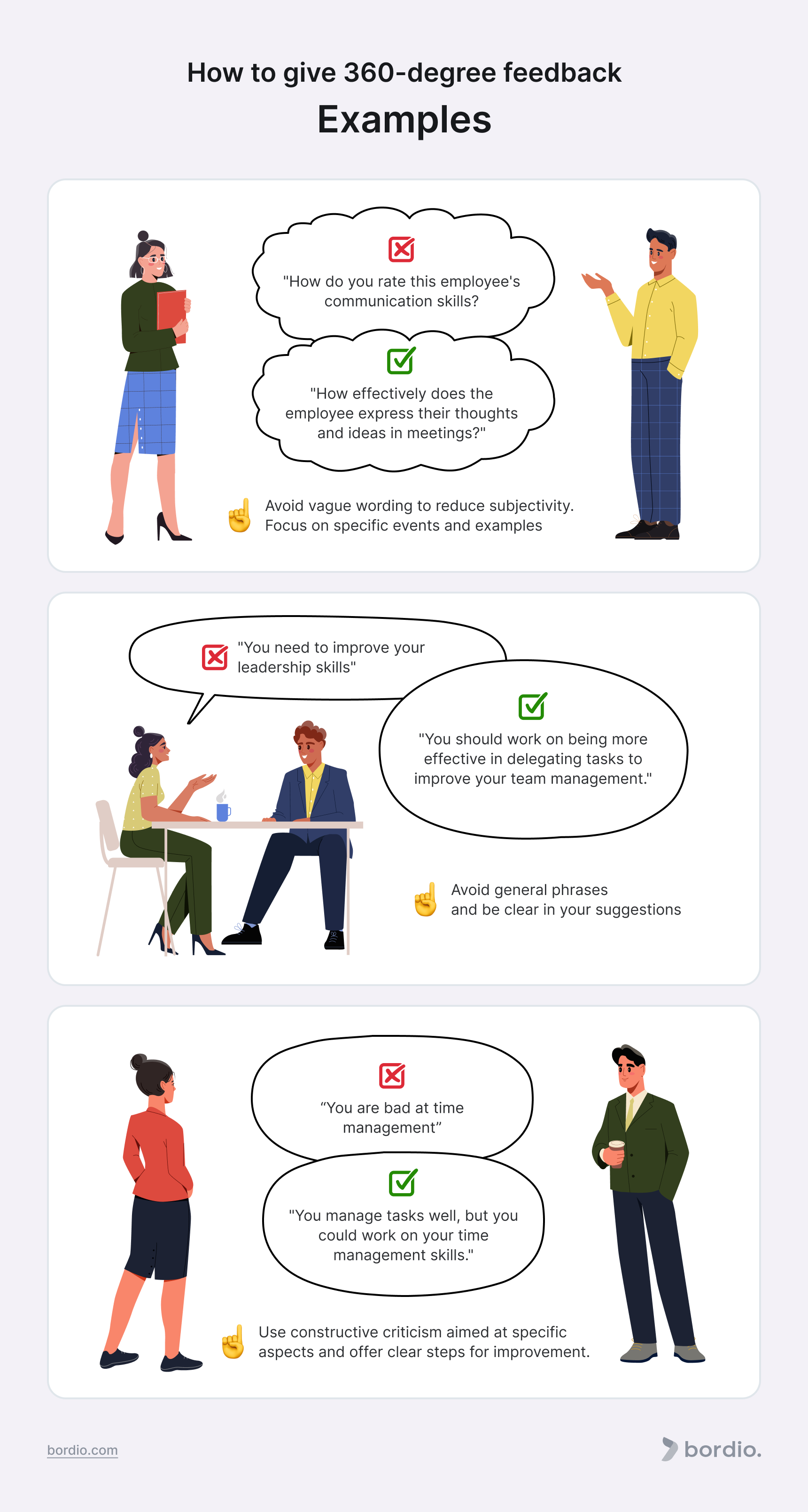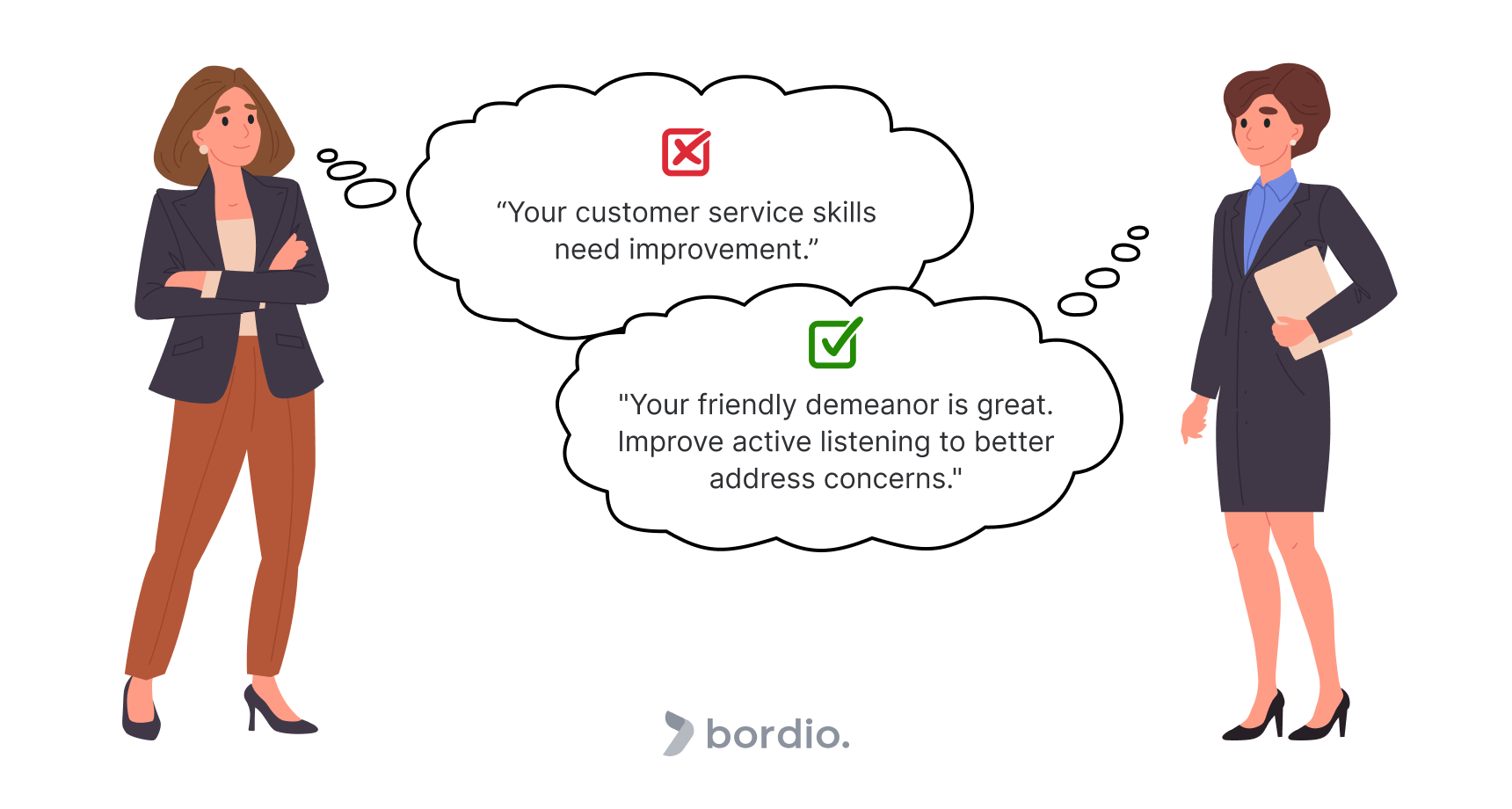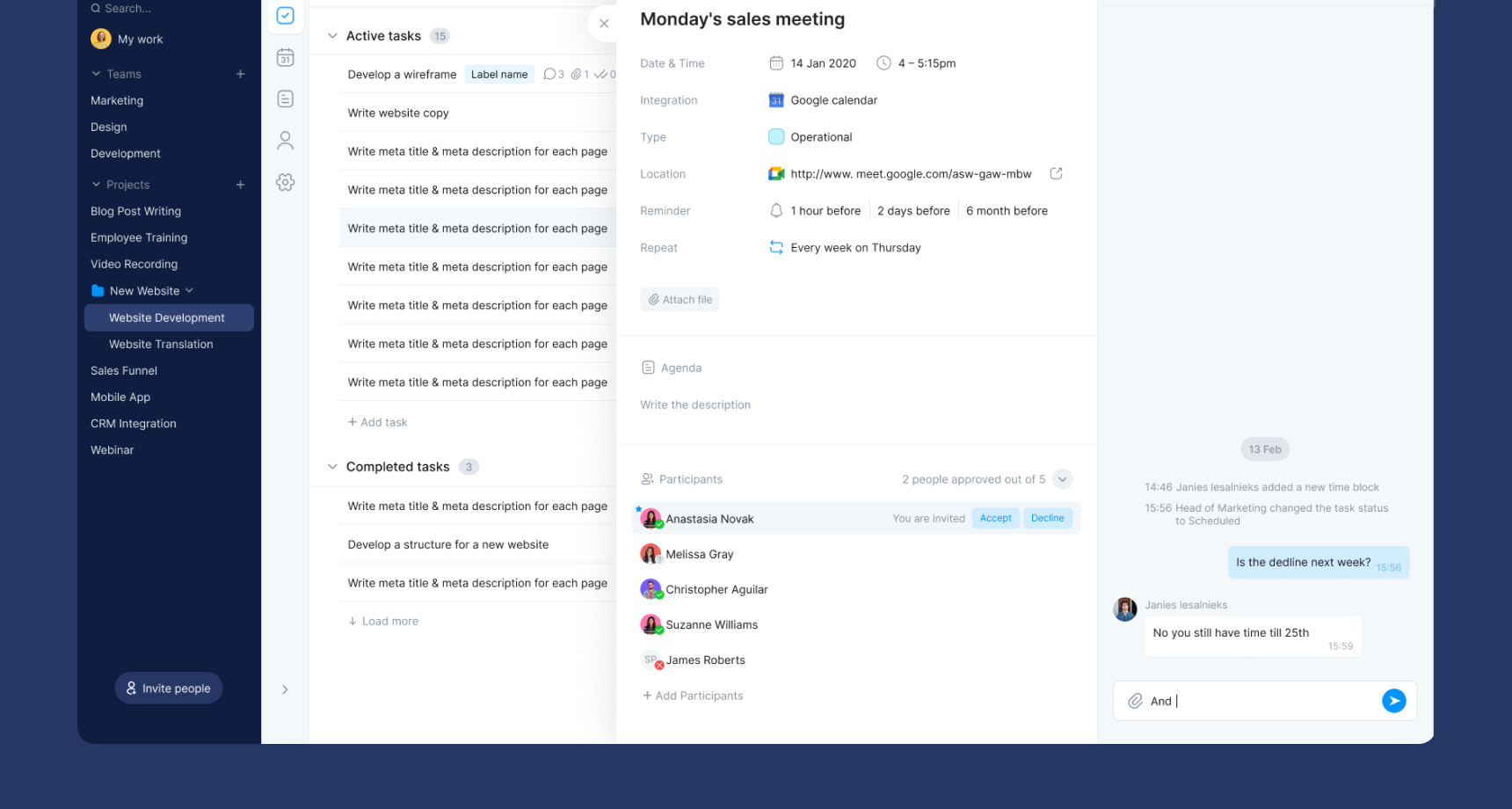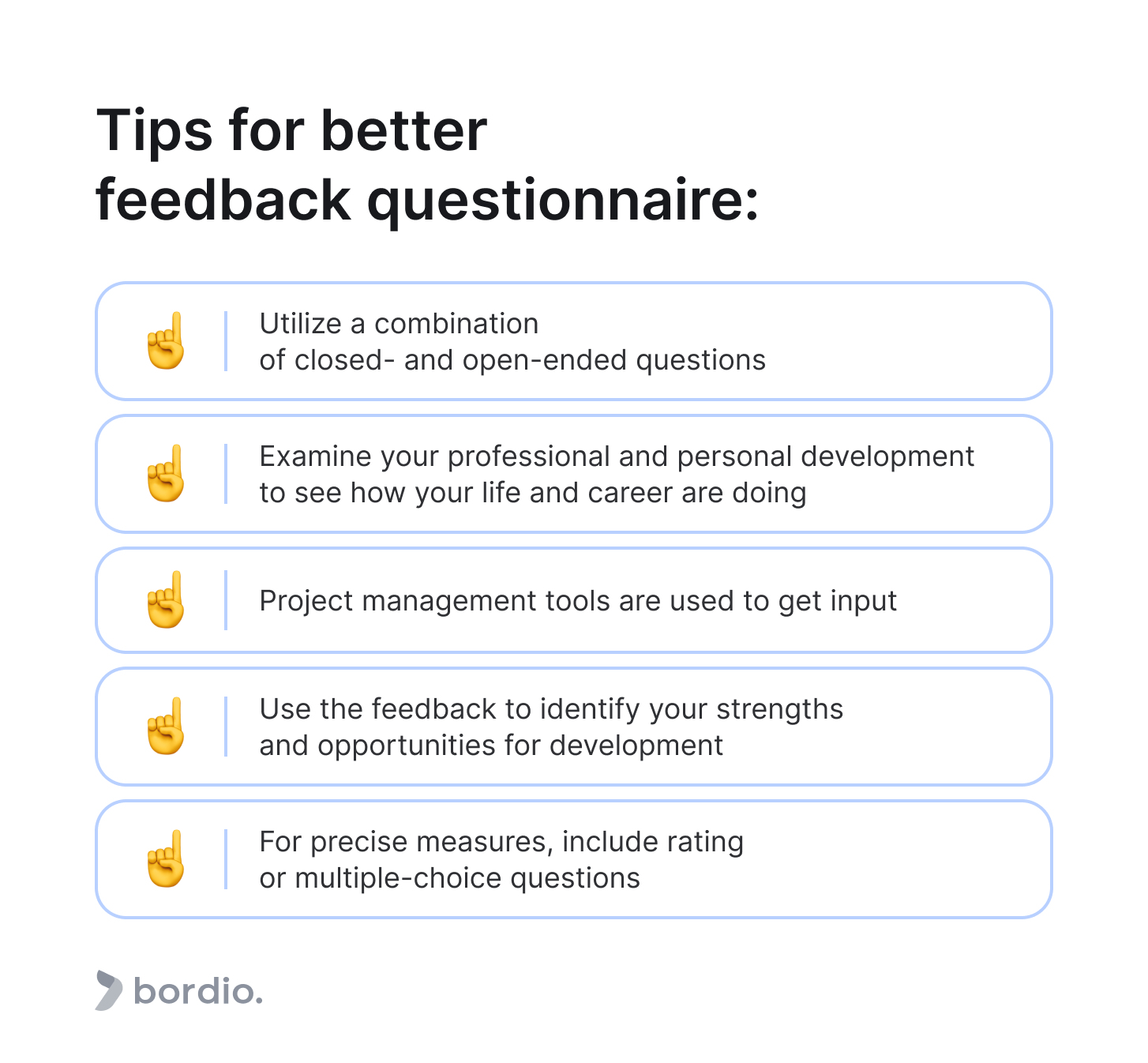Employee feedback is essential for a business to succeed and for employees to improve. In contrast to typical performance evaluations, 360-degree feedback collects viewpoints from colleagues, supervisors, subordinates, and even outside stakeholders like consumers. This all-encompassing method offers a thorough understanding of a worker’s areas of strength and development. On the other hand, you must comprehend the stages of work and consider instances to execute a 360-degree feedback session properly. Our other articles explain the procedure of 360-degree feedback in more detail. This article examines forty positive and negative feedback examples for a well-rounded perspective!
Critical elements of effective 360-Degree Feedback
First, let’s figure out what 360-degree feedback is and what elements it consists of:
Clarity and specificity
In the 360-degree evaluation, questions should be precise and targeted at observable professional and behavioral qualities. For instance, “How would you rate this employee’s communication skills?” might be too broad for understanding. But, “How effectively does the employee express his thoughts and ideas in meetings?” might be a better question to ask. With the help of this format, the feedback receiver can identify areas that require improvement and take necessary action.
Asking precise and unambiguous questions also helps to improve accuracy by lowering subjectivity in answers. Respondents can better recall particular occurrences and offer more unbiased and beneficial feedback when well-crafted questions concentrate on specific events and examples. This is particularly crucial when using a 360-degree perspective, as it gathers many points of view and calls for organized data. To prepare such specific questions, you should analyze previous work and performance; in Bordio, for example, you can examine all earlier tasks and each team member’s general workload. This approach is useful for healthy workload balancing.
Furthermore, giving employees clear instructions about the questions they will be asked helps them prepare for it. As a result, they may better prepare for the feedback process and be motivated to take a targeted approach to enhance their professional behavior and skill set. Employees can take a proactive approach to planning and allocating work, for instance, by being aware that their time management skills will be evaluated. They might start using time management tools. It will enhance their openness to share outcomes and take actionable feedback.
Balanced approach
The feedback should tag both the right and wrong things done. This approach fosters the employees’ commitment by praising them for their excellent work and correcting them in the areas they should improve. In a motivational context, positive reinforcements should be used to increase the employees’ morale and self-confidence. For instance, praise fosters their self-esteem when a complicated task from a team’s task planner is successfully finished or a group has completed a big project.
Constructive criticism, in the same way, should target certain aspects that should be changed and include recommendations to be implemented. Rather than saying, ‘You should work on your leadership,’ it is more constructive to say, ‘You should consider being more efficient at delegating to enhance your team management skills.’ This way, the critique is more practical and beneficial for the target’s development.
Confidentiality and trust
Anonymous feedback promotes honest feedback by ensuring respondents feel comfortable providing candid insights without fear of repercussions. To ensure privacy, use anonymous online platforms or paper questionnaires without entering your name. This creates an atmosphere of trust where employees understand that their opinions will be used solely to develop and improve the work environment and not for punishment.
Comments such as ‘Let me remind you that the primary goal of the 360-degree review is….’ or ‘I assure you, your feedback will be kept confidential’ will foster the organization’s more effective functioning. Trust in the feedback process increases effectiveness and allows you to collect more accurate and helpful information for further analysis and improvement.
Using management tool
Bordio efficiently manages the 360-degree feedback process by organizing every step, from setting up surveys to analyzing the results. This is especially useful software for remote work! You can assign tasks to team members, collect and analyze data so everything runs smoothly, and set deadlines.
Bordio also facilitates teamwork, allowing you to work with your team on multiple projects. But what is more important is that you can receive qualitative feedback in Bordio. It allows employees and managers to discuss feedback in real-time! How? Just click on any task, and then you will see a chat similar to WhatsApp. In such a chat, leaving feedback and asking questions becomes much easier because you don’t need to close your planner and ask something through the messenger application or call. With this project management planner, you can also stay on top of deadlines and track progress efficiently throughout the 360-degree feedback process.
20 Examples of positive feedback
When giving positive 360-degree feedback, we highlight the manager’s strengths and encourage them to continue their excellent work. Positive feedback on their work increases their morale, motivation, and confidence and results in higher productivity. It is all about recognizing their accomplishments and using them to their fullest potential.
Here are examples of positive 360-degree feedback:
Conflict resolution
- “Your impartiality, constructive approach, and strong interpersonal skills in handling disputes are highly valued. You manage to resolve conflicts swiftly and effectively.”
- “Your empathetic handling of conflicts helps calm tense situations and leads to positive outcomes for all parties involved.”
- “Thank you for taking the time to uncover the root causes of conflicts. This proactive approach helps prevent future issues and fosters a more collaborative and supportive work environment.”
Mentorship and guidance
- “I appreciate all of your mentoring and advice. Your helpful criticism has aided my professional development, and I am grateful for your encouragement.”
- “Your constant guidance and assistance have been crucial in helping me overcome obstacles and realize my full potential.”
- “Your focus on our advantages and provision of chances for development gives me a sense of worth and involvement in the group.”
Leadership skills
- “You are truly an inspiring leader! Your example motivates me to strive for my best.”
- “I appreciate how clearly you articulate the team’s goals and how our work fits into the larger picture. It helps me stay focused on what matters most.”
- “Under your leadership, we have developed a strong team culture where everyone is accountable and supportive. Your direct reports consistently provide positive feedback on your delegation practices and overall effectiveness.”
Motivational skills
- “Your ability to inspire the team to excel is unmatched and has led to outstanding results.”
- “I value how you recognize and appreciate our hard work. It’s encouraging to know our efforts are noticed.”
- “Thank you for always providing growth and development opportunities. It keeps me motivated and engaged in my work.”
Productivity
- “I can see in the team’s task tracker and project tracker that the team has been able to accomplish outstanding outcomes and finish projects on schedule and within budget because of your attention to efficiency, productivity, and employee performance.”
- “Our production has increased dramatically due to your advice, which encouraged us to rank jobs according to significance. We are working faster and achieving more, finishing all to-do’s”
- “It’s clear that the team is more productive, and it’s all because of your concentration and leadership. Seeing how much we can do when we collaborate to pursue a common objective is motivating.”
Work environment
- “I’ve noticed that the team’s outlook on work has improved lately. Your efforts to establish a good work atmosphere have a big effect.”
- “Your open-door policy is greatly appreciated as it promotes open and free communication among team members.”
- “It’s clear that all team members have a sense of unity and purpose in pursuing the same objectives. That is a very amazing feat.”
Communication skills
- “You excel at explaining things clearly and understandably, which I believe contributes to the team’s efficiency and productivity.”
- “Your active listening skills are impressive. Your ability to hear and acknowledge different perspectives has helped resolve conflicts and foster a collaborative work environment.”
20 Examples of negative 360-degree feedback
Constructive or redirecting feedback, in turn, focuses on areas where they can improve.
It’s not about criticizing or tearing them down but instead highlighting areas for improvement and offering specific suggestions. This type of 360 feedback is intended to guide their behavior towards a more productive and positive outcome. When forming criticism, do not put pressure, point out what was done poorly, and be sure to tell how to fix it.
Here are examples of constructive 360-degree feedback:
Productivity
- “I have been tracking your productivity, and I see that you are struggling. Balancing the current emphasis on short-term productivity with work-life balance could help prevent burnout and enhance long-term productivity.”
- “I see a decrease in productivity on this project. Giving team members more opportunities to provide feedback on workflows and processes can help identify areas for improvement more quickly.”
- “They are performing poorly. Disbanding this department and collaborating with a b2b marketing agency would be more productive.”
Mentorship and guidance
- “Regular feedback is welcome, but you should focus more on constructive feedback with specific examples, and your performance will improve.”
- “It would be helpful to have more coaching knowledge focused on specific areas for improvement. Perhaps you should take this training.”
- “Compared to my previous positions, there are fewer opportunities to take on new challenges and develop my skills. Can we explore ways to solve this problem?”
Leadership skills
- “Your project input is valuable, but reducing micromanagement and giving team members more autonomy would be empowering.”
- “Creating more opportunities for team members to contribute to decisions and have their voices heard would be appreciated.”
- “You have great leadership potential. Emphasizing leading by example and modeling the expected behaviors and values would enhance your leadership.”
Motivation
- “While bonuses and other external motivators are appreciated, emphasizing intrinsic motivators like meaningful work and personal growth would be beneficial.”
- “Your willingness to address individual needs is helpful, but improving team bonding and collaboration would enhance overall motivation.”
- “There seems to be a lack of motivation among team members. Identifying the root cause and addressing it together would be helpful.”
Work environment
- “Your efforts to create a positive work environment are appreciated, but offering more varied team-building activities outside of work could be beneficial.”
- “Increasing transparency and communication about company goals and expectations could foster a more collaborative work environment.”
- “The marketing department is a bad influence on the work environment. Have a conversation with them, or we will start work with a better marketing agency.”
Communication skills
- “Your clear communication style is appreciated, but it would be beneficial to provide more opportunities for team members to offer feedback on their needs.”
- “Focusing more on active listening and acknowledging others’ perspectives during discussions would improve overall communication by providing valuable insights.”
- “While your instructions are clear, more communication about the reasoning and impact of certain decisions on the team and project would be helpful. Use our team management software to analyze before creating new instructions.”
Conflict resolution
- “While compromise is important, creating more opportunities for team members to express their needs and concerns in a safe and anonymous environment would be beneficial.”
- “Implementing a plan to manage workloads and prevent stress-induced conflicts would help reduce tension and improve team dynamics.”
Examples of questions for comprehensive 360-degree feedback
A 360-degree feedback questionnaire is a performance appraisal method distinct from a typical performance review system. This means the questions one should ask should be in a different format altogether! This is why managers tend to have some issues with 360-degree feedback: the questions are insufficient to make a deduction.
You require the best 360-degree feedback survey containing open-ended and close-ended questions. These questions should assess an employee’s growth in aspects of his or her life and career. Project management tools can easily collect feedback from multiple organizational sources for comprehensive performance evaluation and employee development.
Thus, open-ended and close-ended questions should be combined when getting all the needed data. When implemented effectively, the 360-degree feedback survey is a valuable tool for assessing an employee’s strengths and areas of improvement. Indeed, it is time and energy well spent to do it right!
Over time, close-ended questions allow the employer or the manager to decide if an employee deserves an appraisal of quantitative information on the employee. These can be rating-scale or multiple-choice questions, as the case may be. These questions are structured to allow managers to measure each aspect of an employee’s performance and development over a certain period. Here are ten questions you should ask:
- Does this employee make the best of their time in the office?
- Do you think this employee is honest and ethical when making critical decisions?
- Does this employee take feedback seriously and try to improve?
- Is this employee empathetic to customers?
- Has this employee willingly taken on any projects?
- Does this employee go the extra mile to make customers happy?
- Does this employee contribute to a healthy work environment?
- Does this employee align their performance with the company’s goals and interests?
- Does this employee help co-workers with issues?
- Do you rely on this employee when facing obstacles in the workplace?
Benefits of 360-degree feedback
So, we know what 360-degree feedback is and have considered examples. What are the advantages of this method?
Comprehensive understanding
It is good for organizations to get feedback from as many references as possible and, therefore, see and know all an employee can deliver. Superintendent – or manager-only appraisals may not be sufficient, as features may be outside the scope of the superior’s observations.
To offer a holistic perspective, feedback comes from other people, especially colleagues, juniors, and occasionally clients. It presents specifically what is good and weak and gives a much more authentic and arguably fairer overall picture of what was offered.
Increasing self-awareness
The insights gained can inspire personal change and development, motivating employees to improve their skills and approaches. For example, after becoming aware of their tendency to micromanage, an employee can work to improve their delegation abilities. As a result, the employees gain information concerning their talents and weaknesses and contribute to their improvements. This kind of feedback reinforces how people view themselves from other people’s perspectives and how others view them in mannerisms and conduct.
Improving team communication
Professional relationships are strengthened through 360-degree feedback, which promotes open communication and trust among team members. To create a more collaborative work environment, you should implement collaborative tools, such as a project planning board, into your work. Regular feedback exchange helps teams better understand each other, resolve conflicts, and achieve their goals together.
When employees see that their opinions and contributions are valued and considered, they create more robust, cohesive teams. Open feedback also helps develop practical communication skills and resolve problems before they become serious conflicts.
Purposeful development
Feedback helps identify areas for improvement, including problem-solving skills, allowing you to develop personalized development plans. These plans may include training, coaching, and mentoring to strengthen weaknesses and further develop strengths.
For instance, if performance appraisal portrays an employee as a candidate for development in project management, then it is possible to facilitate the training for this kind of development. This consolidation enhances the employees’ efficiency and satisfaction, which catalyzes organizational success.
Final Thoughts on 360-degree feedback examples
360-degree feedback is a potent instrument for promoting organizational expansion and staff development. Through the integration of many viewpoints and an emphasis on practical understandings, establishments can foster an environment of ongoing enhancement and accomplish enduring prosperity. This strategy improves individual performance while strengthening team relationships and the corporate culture. If implemented with precision and success, 360-degree feedback could produce a more robust and malleable workforce regarding change, increased workers’ involvement, and organizational commitment to achieve organizational objectives. Think of using work management tools like Bordio to make the 360-degree feedback process easier.
In personal and professional relationships, sustaining a competitive position and achieving long-term success means organizations must incorporate elaborate feedback mechanisms for engaging with complex and dynamic environments.








